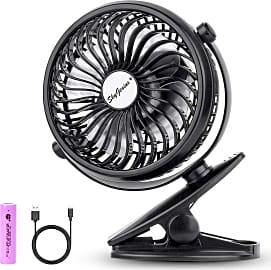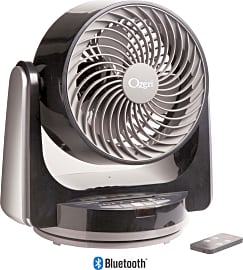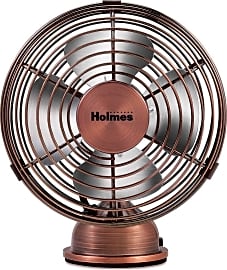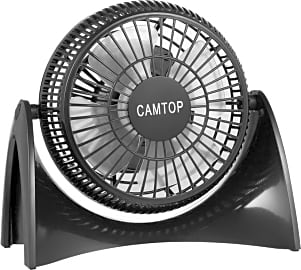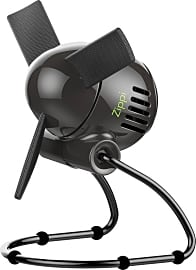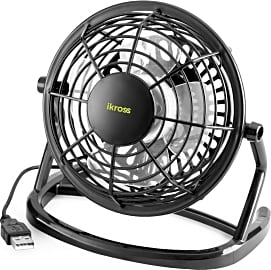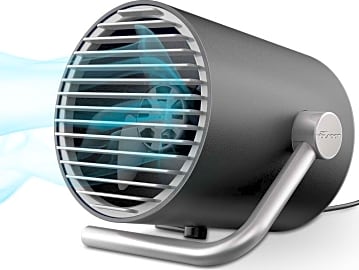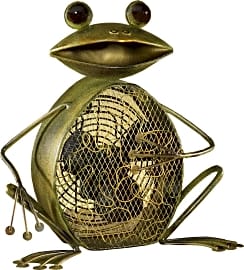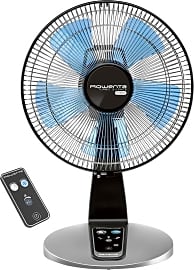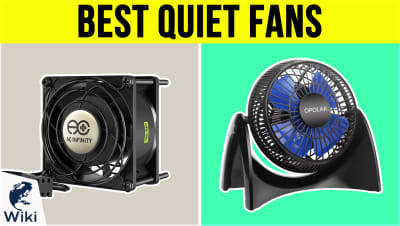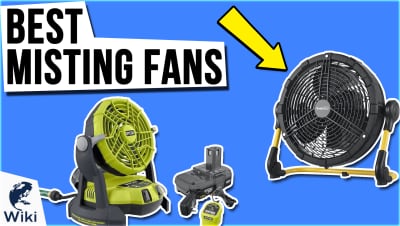The 10 Best Desk Fans

This wiki has been updated 38 times since it was first published in March of 2016. If you wish that things were a little bit cooler at home, in your office, or in bed, then you should try one of these compact and portable desk fans. Our selections for this category will all sit unobtrusively on any tabletop, and they are available in a wide variety of designs to suit all styles, allowing you to remain comfortable without cranking up the air conditioner. When users buy our independently chosen editorial choices, we may earn commissions to help fund the Wiki.
Editor's Notes
January 22, 2021:
It turned out to be a surprisingly stable category, as we saw no need to add or replace any items during this update, feeling that our existing choices continued to be some of the category's best. As well as offering a host of competitive features and ratings, we thought that the selections curated by this page's last editor covered a healthy assortment of aesthetics, and should provide options of interest to users with various personal styles.
We maintain a myriad of these fan categories. So, depending what you're specifically looking for, you may also want to check out our lists of quiet fans, battery-powered fans or even misting fans.
December 09, 2019:
Three models were unavailable and thus needed to be removed: the Thermaltake Mobile, Honeywell TurboForce and Dizaul Mini. Two additional models (the Ozeri Brezza III and Rowenta Turbo) required updating, as newer versions were available. We made the necessary changes to those options and eliminated one other model due to reports of poor performance.
The Volador Touch — one of the newly introduced items — does not look like your typical desk fan, ditching the circular, grated design for a more tubular style. While it looks stylish and contemporary and seems very easy to operate, it doesn’t appear to be as quiet as some of the other available options.
The SkyGenius Clip is perhaps the most consistent performer of the new additions, and its clip-on design makes it one of the most versatile as well. Since it has a rechargeable battery, it doesn’t need to be plugged in whenever it’s in use, which adds an element of convenience.
Special Honors
Dormify USB The all-steel construction of the Dormify desk fan makes it a bit more durable than many of its plastic counterparts, and it produces a stiff breeze despite its miniature size. Its tilting mechanism enables you to push air up or down as needed, and it comes with a 90-day return policy. dormify.com
Qushini Portable The soft pastel-style colors (pink and off-white) of this model are easy on the eyes, and the noise level when in operation is negligible. Thanks to its pedestal base, you can simply stand it on a level surface or use it as a handheld device while you’re driving or taking public transportation. qushini.com
Making Comfort A Breeze
The majority of desk fans available are categorized as axial-flow fans, which move air in a direction parallel to the shaft around which their blades are rotating.
Depending on a person's working environment, not many things can instantly improve its quality when it gets super hot. Regardless of whether you work at home or in the office, the right kind of breeze with refreshingly cool air from a powerful desk fan can greatly improve your work ethic and energy level.
A fan is an air circulation machine that is designed to produce flow or movement of a gas using a rotating assembly (or hub) of vanes or blades. This hub is often referred to as an impeller or rotor. The blades are usually housed in a durable casing to prevent injury or other objects from coming into contact with them. The majority of desk fans available are powered by electric motors and work by evaporative cooling. The desk fan itself is usually small in size, portable, and equipped with a swiveling head that allows it to oscillate across a wide space to keep the user cool.
Desk fans fall into two categories, battery-powered and mains-powered. Battery-powered fans clip onto the edge of an office desk and run on a single power setting, while mains-powered fans stand upright and have multiple speed settings. Although battery-powered units are more portable and less expensive than mains-powered desk fans, they are a temporary solution. Mains-powered fans are more powerful, more effective, they last longer, and they are considered a permanent solution for keeping cool.
The majority of desk fans available are categorized as axial-flow fans, which move air in a direction parallel to the shaft around which their blades are rotating. An axial-flow desk fan has several operating components, including a fan blade, base, armature, motor, blade guard, motor housing, oscillator gearbox, and an oscillator shaft. A ceiling fan's motor moves in a counter-clockwise direction (as do its blades) while its armature remains stationary.
By contrast, a desk fan's electric motor is always stationary, giving the armature a push in order to provide motion to its attached blades. The blades then spin in a clockwise direction due to Newton's third law of motion. The armature shaft extends from both sides of a fan's motor with one end of the shaft attached to the blade, while the other end is attached to the oscillator gearbox.
The motor case is connected to the gearbox in order to contain both the rotor and stator (the stationary part of the fan's rotary system). The oscillator allows the fan's head to move from side to side when the unit is turned on. The oscillator shaft is connected to both the base and the gearbox. The motor housing protects the oscillator mechanism, while the blade guard joins to the motor housing for extra safety.
Desk fans are most popular for use in office settings and schools among other places. This is primarily due to their compact design and ability to be transported and placed almost anywhere. Some desk fans are stationary, meaning that they don't turn, while others are capable of oscillation in situations where a desk or table may require a wider range of cooling. Desk fans are usually made from lightweight plastic and are equipped with long power cords, making them easy to place on a flat surface above a nearby outlet without running out of slack.
Whatever Direction The Wind Is Blowing
One thing to keep in mind about desk fans is that they aren't uniform in shape like larger fans designed to sit in a particular location. They come in a variety of different shapes, sizes, and colors, which means that one does not have to sacrifice style for functionality.
It should also be easy to move, adjust, with several available speed settings, and have the ability to oscillate back and forth to move large amounts of air.
If you're into modernity and cutting-edge technology, for example, desk fans come in bladeless designs that are safe and relatively easy to clean. Additionally, a desk fan powered by a universal serial bus (USB) interface can plug right into your computer, which comes in handy when space is an issue and you don't want to be dealing with a lot of bulky cords. Some of the most modern desk fans also feature intuitive digital touch controls with remotes that can be used from across the room to change their settings.
The fan one invests in should be relatively quiet, regardless of whether its design is bladeless or not. It should also be easy to move, adjust, with several available speed settings, and have the ability to oscillate back and forth to move large amounts of air.
Finally, one must ensure the fan chosen has some type of overload protection built into its design. This can help to prevent short circuits and potential fires. In situations where you may be sharing a room with children or pets, some fans even have flexible or soft cloth blades that are safe to touch when the unit is running.
A Brief History Of Desk Fans
Some of the earliest fans date back to around 3,000 BCE during the time of the ancient Greeks and Romans who used them to keep cool as well as for both religious and ceremonial purposes. These early fans were made from materials that included feathers, paper, jewels and wood, with the more elaborately-decorated fans being large and used to indicate wealth and power.
These fans were adapted and specially decorated to suit the particular style of the time.
The first hand-held fans are thought to have originated in China as early as the second century BCE and were constructed from woven bamboo. Fast forward to the seventeenth century and fans from China were being exported in large quantities to Europe, where they essentially became a part of the costume for European women. These fans were adapted and specially decorated to suit the particular style of the time. This period of time also saw the rise in popularity of the Indian punkah fan.
Between 1882 and 1886, New Orleans resident Schuyler Skaats Wheeler invented the first fan powered by electricity. It was a desktop, two-bladed unit that was marketed by the Crocker and Curtis Electric Motor Company. By 1909, mass-produced electric fans for home use began to appear on the market, followed by industrial advances with steel that allowed fans to be designed in a variety of different shapes at affordable prices. By the 1950s, desk fans were being produced in many different styles and colors, which is a manufacturing trend that still continues today.


